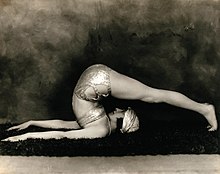Marguerite Agniel
Marguerite Agniel | |
|---|---|
 | |
| Born | January 21, 1891 |
| Died | Circa 1971 |
| Nationality | American |
| Known for | Actress, dancer |
Marguerite Agniel (1891 – c. 1971) was a
After appearing in
Agniel stated that her dance technique derived from Ruth St. Denis (who had followed
Early life
Marguerite, born January 21, 1891, Marguerite was born January 21, 1891, one of the six children of George Agniel and Ada Lescher Flowers. Her father was an Indiana farmer. He died in 1893 while she was an infant, leaving her mother to raise the children alone.[1] The Agniel family was French-Jewish; her mother's family was English.[2] She was married in New York on March 21, 1917.[3]
She performed in Broadway plays including The Amber Empress with music by Zoel Parenteau in 1916, and Raymond Hitchcock's Pin Wheel in 1922.[4][5]
Author
She appeared in the November 15, 1926, issue of
She wrote for
In 1931 Agniel wrote the book The Art of the Body: Rhythmic Exercise for Health and Beauty, illustrated mainly with photographs of herself;
Agniel wrote a piece called "The Mental Element in Our Physical Well-Being" for
-
In "Buddha position",Muktasana. Photograph by John de Mirjian, c. 1928
-
InSupta Virasana, demonstrating "A good exercise for the back and abdominal muscles". Photograph by John de Mirjian, c. 1928
-
"As Mona Lisa" by Robert Henri, c. 1929
-
Topless, c. 1923
Reception

Her friend the sexologist Havelock Ellis wrote in a letter to Louise Stevens Bryant (May 17, 1936) that Agniel's books were "full of beautiful illustrations, nearly all of herself. She has a wonderful art of posing, & they are largely nudes, though she is no longer young."[2]
Agniel is depicted in an "elegant, though sharply ironic"[13] Palladium photographic print by the Canadian photographer Margaret Watkins, "Head and Hand". It shows her hand holding a portrait sculpture head of herself by Jo Davidson.[13] This was one in a series of portraits of Agniel by Watkins that Agniel used in The Art of the Body. Devon Smither describes Agniel as "a leading health and beauty guru",[14] and the Art of the Body as "a moralizing exercise manual" providing a mixture of exercises, advice on cosmetics, and spiritual guidance.[14]
The scholars Mary O'Connor and Katherine Tweedie comment on Watkins's portraits of Agniel that they were circulated sometimes as artistic "nudes", sometimes as portraits, and sometimes as instances of "a regime of exercise and body modification".[15] They write that since Agniel chose to use these photographs of herself, she is presenting them "not as the passive victim of an objectifying male gaze ... but as the means of promulgating her own vision of the world and her own expertise. She circulates her body as an image of the ideal and for commercial profit."[15]
Works
- 1931 The Art of the Body. London: Batsford.
- 1931 "Dancing Mothers and Dancing Daughters", Hygeia 9:344-348
- 1933 Body Sculpture. New York: E.H. & A.C. Friedrichs.
- 1936 Your Figure. Garden City, N.Y.: Doubleday, Doran & Company.
- ——— also published in 1936 as Creating Body Beauty, New York: Bernard Ackerman.
See also
References
- ^ Bateman, Dominique; Pikaart, Miranda (2020). "Biographical Sketch of Lucille Agniel Calmes". Online Biographical Dictionary of Militant Woman Suffragists, 1913–1920. Retrieved August 21, 2020.
- ^ a b Ellis, Havelock. "Letters to an American". Virginia Quarterly Review (Spring 1940).
- ^ Married March 21, 1917, Manhattan New York, certificate no. 9261. Index to New York City Marriages, 1866–1937.
- ^ "Marguerite Agniel". Internet Broadway Database. Retrieved November 5, 2019.
- ^ "Zoel Parenteau, Stage Composer". The New York Times. September 15, 1972. p. 40.
- ^ Peters, Lauren Downing (May 31, 2018). Stoutwear and the Discourses of Disorder: Constructing the Fat, Female Body in American Fashion in the Age of Standardization, 1915–1930 (PDF). Stockholm University (D. Phil. Thesis). pp. 305, 307.
- ^ "au:Marguerite Agniel". WorldCat. Retrieved November 5, 2019.
- ISBN 978-1-916215-11-5.
- ^ Routledge, Isobel (November 28, 2014). "Meditation and modernity: an image of Marguerite Agniel". Wellcome Library.
- ^ OCLC 1069247718.
- ISBN 978-1-4985-2803-0.
- OCLC 1056781478.
- ^ a b c d "Modern Scottish Women / Painters and Sculptors 1885–1965". Georgina Coburn Arts. January 27, 2016.
- ^ S2CID 150507132.
- ^ ISBN 978-0-7735-7566-0.





